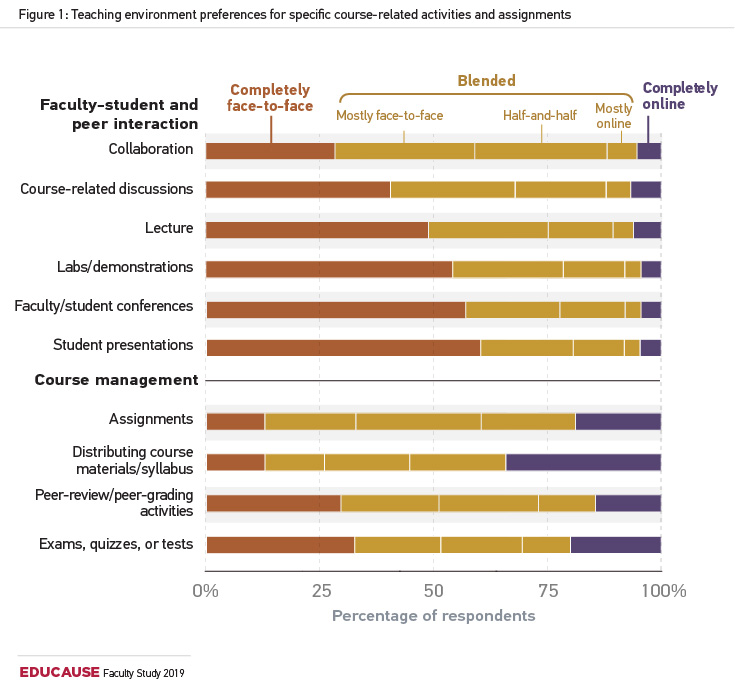IBL News | New York
Why is faculty so opposed to digital learning?
Even with increased online course offerings, only 9% of faculty said they prefer to teach a class that is mostly or completely online. About half (51%) prefer to teach courses that are blended, i.e., face-to-face with some use of the online learning environment. And 73% prefer a teaching environment that is either completely or mostly face-to-face.
This finding was revealed by the “2019 Study of Faculty and Information Technology” developed by the Educause Center for Analysis and Research (ECAR). This research, posted this past Monday, draws on survey data from more than 9,500 faculty across 119 US institutions. [Full Report, PDF]
According to the study, faculty still want to see the faces of their students, but they also want to use the online learning environment to do more mundane tasks, such as distributing syllabi. As we found in 2017, previous teaching experiences continue to influence preferences for current teaching environment.

Among faculty, Baby Boomers and members of Gen X, were twice as likely as millennial instructors to prefer teaching fully online. Due to their experience and tenure status, older professors may have more freedom to experiment with new kinds of instructional tools and formats.
Other key findings are:
- Many faculty aren’t using online student success tools, but when they do use them, a majority find them at least moderately useful.
- Faculty satisfaction with their overall technology experience has declined slightly. When faculty have good or excellent experiences with IT support services, their overall technology experience is good or excellent.
- Faculty give high ratings to support services for accessibility technology when they use them.
As for recommendations, Educause provides clear guidance to engage faculty to embrace technology:
- Promote benefits and strategies for engaging in online teaching through mentoring and the creation of sustainable learning communities. Academic departments need to consider changes to their tenure requisites to reward faculty who choose to engage in course development and online instruction. Faculty report strong preferences for face-to-face learning environments, but with increasing offerings and enrollments in online classes, institutions need to provide professional development to faculty who have the interest and skills to teach online.
- Communicate to faculty and students the benefits of advising technologies. Gain buy-in by understanding faculty needs and advising processes, and integrate these technologies into existing software platforms.
- Increase awareness among IT support services staff that quality services for faculty contribute to faculty’s overall ratings of their technology experiences. IT support staff are first responders to faculty technology issues and can make a real difference in faculty experiences. Ensuring faculty satisfaction in using remote-access software is an area where IT support services can improve faculty technology experiences. In addition, engagement with help desk services is associated with faculty’s overall satisfaction with technology experiences at their institution.
- Facilitate faculty professional development on integrating technology into teaching. Promote professional development for faculty on effectively incorporating mobile technologies into their classrooms. Bans on all technology devices in the classroom will likely decrease student engagement. These bans disproportionately affect minority students and students with disabilities needing accommodations. Quash the “devices in the classroom” debate by leveraging mobile technologies in students’ hands to increase engagement and learning.
- Increase faculty awareness of student needs and accessibility support services, particularly among non-AA institutions. Disability disclosure rates remain low among students, limiting faculty awareness and ability to address accessibility needs in the classroom. When faculty use accessibility support services, however, they report high levels of satisfaction with those services.

 En Español
En Español




















